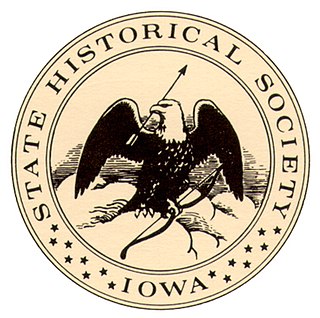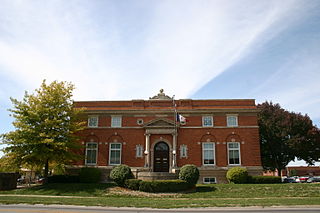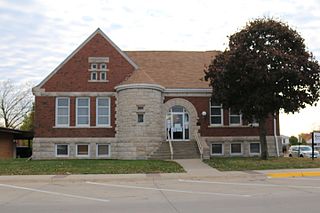
Des Moines is the capital and most populous city in the U.S. state of Iowa. It is the county seat of Polk County with parts extending into Warren County. It was incorporated on September 22, 1851, as Fort Des Moines, which was shortened to "Des Moines" in 1857. It is located on, and named after, the Des Moines River, which likely was adapted from the early French name, Rivière des Moines, meaning "River of the Monks". The city's population was 214,133 as of the 2020 census. The six-county metropolitan area is ranked 81st in terms of population in the United States, with 709,466 residents according to the 2020 census by the United States Census Bureau, and is the largest metropolitan area fully located within the state.

The State Historical Society of Iowa (SHSI), a division of the Iowa Department of Cultural Affairs, serves as the official historical repository for the State of Iowa and also provides grants, public education, and outreach about Iowa history and archaeology. The SHSI maintains a museum, library, archives, and research center in Des Moines and a research library in Iowa City, as well as several historic sites in Iowa. It was founded in 1857 in Iowa City, where it was first affiliated with the University of Iowa. As the organization grew in size and collections, it became a separate state agency headquartered near the Iowa Capitol in Des Moines.

Humboldt Public Library in Humboldt, Iowa, USA, is a free public library. The library received a $10,000 grant from the Carnegie Corporation of New York on December 13, 1906. The Des Moines architectural firm of Hallett & Rawson designed the building. It was built using limestone from a nearby area now known as Taft Park. Construction began in 1908 and it was dedicated on February 9, 1909. The rough texture of the rock-faced stone and the portico columns in the Tuscan order give the building a rustic appearance. It was listed on the National Register of Historic Places in 1983. A north entrance and extension were added to the building in 1992.

Proudfoot & Bird was an American architectural firm that designed many buildings throughout the Midwest region of the United States. Originally established in 1882, it remains active through its several successors, and since 2017 has been known as BBS Architects | Engineers.

The Old Downtown Des Moines Library is a historic building in downtown Des Moines, Iowa, United States that was built in 1903. It was individually listed on the National Register of Historic Places in 1977, and became a contributing property in the Civic Center Historic District in 1988. The building ceased to be a library in 2006 and now houses the Norman E. Borlaug | World Food Prize Hall of Laureates for the World Food Prize.

Ottumwa Public Library is a public library located in downtown Ottumwa, Iowa, United States. The current building was built in 1902. It is part of the Central Park area, which is the civic center of the community. It includes the Wapello County Courthouse, Ottumwa City Hall, and St. Mary of the Visitation Catholic Church. The library was listed on the National Register of Historic Places in 1984.

Liebbe, Nourse & Rasmussen was an architectural firm in the U.S. state of Iowa. They designed Kromer Flats built in 1905. It designed courthouses, commercial buildings, and residences. Several are listed on the U.S. National Register of Historic Places.

The Perry Carnegie Library Building, also known as the Carnegie Library Museum, is a historic structure located in Perry, Iowa, United States. The Perry Library Association was established in 1894, and William Tarr served as its first librarian. Andrew Carnegie accepted Perry's application for a grant for $10,600 on January 13, 1903. The Des Moines architectural firm of Liebbe, Nourse & Rasmussen designed the Neoclassical building that was built by local contractor Courtney and Bolt. It opened in September 1904 was dedicated on December 10.

Frank E. Wetherell was an American architect in the Midwest U.S. state of Iowa who was active from 1892 to 1931. Frank Wetherell was educated in the Oskaloosa, Iowa schools, and went on to Iowa City where he first studied civil engineering at the State University of Iowa, then changed to the field of architecture. It appears that he began his professional career in Oskaloosa in 1892, at the age of twenty-two. Following his marriage in 1894 to Amy Loosley, the couple moved to Peoria, Illinois, where Frank practiced for four years there before returning to Oskaloosa. The earliest architectural Frank Wetherell commission known in Oskaloosa is the renovation of the N.B. Weeks residence at 407 A Avenue East in 1894. Frank Wetherell founded the second oldest architectural firm in the state in Des Moines, Iowa, in 1905. He worked with Roland Harrison in partnership Wetherell & Harrison. The firm designed numerous Masonic buildings.

Alden Public Library is located in Alden, Iowa, United States. The community's first library association was formed in 1882, and they acquired 225 books. The annual membership fee to use the library was $1. It was discontinued within two years, and Alden's second library association was formed in 1885 by women in the community. In time they were able to build their own building in 1892 and convince the city government to take over its support. Shortly after the city took over they contacted the Carnegie Foundation, who funded the construction of a new building with a $9,000 grant. It was designed by the Des Moines architectural firm of Wetherell & Gage, and shows Beaux Arts styling. The new building was dedicated on August 26, 1914. It is believed to be one of the smallest Carnegie libraries ever built. The building was listed on the National Register of Historic Places in 1981.
The following is a timeline of the history of the city of Des Moines, Iowa, US.

The Burlington Public Library is a public library located in Burlington, Iowa, United States. It dates back to 1868. The library is currently located on Court Street. The previous library building on Fourth Street was individually listed on the National Register of Historic Places in 1975. It was then added as a contributing property in the Heritage Hill Historic District in 1982.

Laurens Carnegie Free Library is a historic building located in Laurens, Iowa, United States. It was designed by the Des Moines architectural firm of Wetherell and Gage and completed in 1910. The Carnegie Corporation of New York had accepted the application for a grant from Laurens' literary association for $3,800 on February 6, 1907. The Mission Revival structure measures 42 by 22.5 feet, and has a projecting pavilion for the main entrance. An addition was built onto the rear of the building in 1955. The building now houses the Pocahontas County Historical Museum. It was listed on the National Register of Historic Places in 1974.

Drake Public Library is a public library located in Centerville, Iowa, United States. It was established in 1901, and the building was placed on the National Register of Historic Places in 1997.

Bloomfield Public Library is a public library located in Bloomfield, Iowa, United States. A library in Bloomfield dates back to the 1870s when a library association was established. One had to pay a subscription fee in order to borrow books. The Carnegie Corporation of New York had accepted the Commercial Club of Bloomfield's application for a grant for $10,000 on November 21, 1911. An election on December 30, 1911, approved constructing new public library in town. The building was designed by Frank E. Wetherell of the Des Moines architectural firm of Wetherall and Gage, and contractor C.W. Ennis constructed it. The new library was dedicated on August 8, 1913. The library is a brick, side gable structure with a projecting entrance on the long side of the building. Both the entrance and the side elevations of the building feature Tudor Revival vergeboards and half-timbered gable ends. The collection includes books in large print, regular print, hard back books and paperbacks, movies, and books-on-CD. Other services include public computers, a young adult section, and a children's area. The building was listed on the National Register of Historic Places in 2015.

Oskaloosa Public Library is a facility located in Oskaloosa, Iowa, United States. Construction of the library was launched in 1902 with a grant from the Carnegie Corporation of New York. The building was added to the National Register of Historic Places in 1991.

Fairfield Public Library is located in Fairfield, Iowa, United States. A library association was founded by a group of local men in 1853, and funded by dues from its members. It was housed in several different buildings for the first 40 years. U.S. Senator James F. Wilson from Fairfield was instrumental in obtaining a grant from Andrew Carnegie for a building of its own. The grant for $40,000 was accepted on January 15, 1892. It was the first Carnegie Library outside of Western Pennsylvania and the first of 101 built in Iowa. It was also one the few libraries Carnegie funded without stipulations concerning its use, public support, or design. The building was designed in the Richardsonian Romanesque style by Kansas City architect C. Stafford. It was officially opened on Friday, September 29, 1893, and it was dedicated on November 28 of the same year. The association continued to run the library until 1899 when voters approved a referendum to support it with taxes. The building has been altered in the ensuing years, and it was listed on the National Register of Historic Places in 1983. The library moved to a new building in 1996, and the historic building is now home to the Jefferson County Service Center of Indian Hills Community College.

The Former Mount Pleasant Public Library is a historic building located in Mount Pleasant, Iowa, United States. The library here was established in 1875. The community applied to Andrew Carnegie for a grant to build a new building, which was accepted on January 13, 1903. They were initially granted $10,000 and then were given a further $2,500. The Chicago architectural firm Patton & Miller designed the Romanesque Revival structure. They adapted Henry Hobson Richardson's Thomas Crane Public Library (1882) for this building. Unlike the Crane Library, this building is primarily brick with rough stone used for a short tower on the main facade and for the trim. It also features an asymmetrical grouping of intersecting gables. The building opened on Wednesday, February 22, 1905. An addition was built onto the rear of the building in 1926. It was designed by the Des Moines architectural firm of Dougher, Rich & Woodburn. The building was listed on the National Register of Historic Places in 1983. The library has subsequently moved to another facility and this building now houses a branch of Southeastern Community College.

The Indianola Carnegie Library is a historic building located in Indianola, Iowa, United States. In November 1902 the local library board submitted a grant application to Andrew Carnegie so they could build a new building. The $10,000 grant was approved on January 13, 1903, and $2,000 was added at a later date. The Indianola City Council agreed to allocate $1,000 a year toward its upkeep. They also bought two lots at the corner of Buxton and Boston. One of the lots was owned by the family of Hannah Babb, the city librarian. Local architect Frederick W. Keith designed the brick Neoclassical structure, and it was built by G.W. James. The library eventually outgrew the building and it was replaced in 1984. The Des Moines Metro Opera has their offices in the old Carnegie building. It was listed on the National Register of Historic Places in 2017.




















